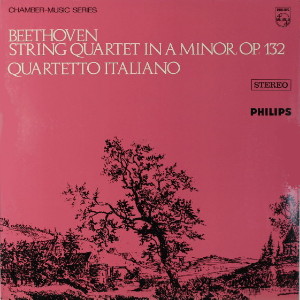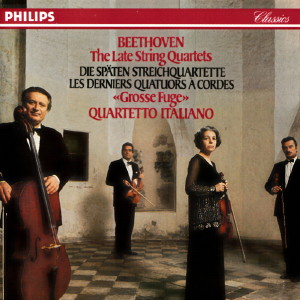 |
|
Philips
- 1 LP - 802 806 - (p) 1968
|
 |
| Philips
- 4 CDs - 426 050-2 - (c) 1989 |
|
| Ludwig van
Beethoven (1770-1827) |
|
|
|
|
|
|
|
| String
Quartet No. 15 in A minor, Op. 132 |
|
47' 10" |
|
-
Assai sostenuto - Allegro
|
10' 00" |
|
|
| -
Allegro ma non tanto |
8' 21" |
|
|
-
Canzona di ringraziamento
(Molto adagio) - Sentendo nuova
forza (Andante)
|
19' 33" |
|
|
-
Alla marcia, assai vivace -
Più allegro - Presto
|
2' 20" |
|
|
-
Allegro appassionato
|
6' 55" |
|
|
|
|
|
|
QUARTETTO ITALIANO
- Paolo Borciani, Elisa Pegreffi, violino
- Piero Farulli,
viola
- Franco Rossi, violoncello |
|
|
|
|
|
Luogo e data
di registrazione |
|
Théâtre
Vevey, Vevey (Svizzera)
- 18-31
agosto 1967 |
|
|
Registrazione: live
/ studio |
|
studio |
|
|
Producer / Engineer |
|
Vittorio
Negri | Tony
Buczynski |
|
|
Prima Edizione LP |
|
Philips | 802
806
| 1
LP | (p) 1968
|
|
|
Prima Edizione CD |
|
Philips | 426 050-2
| 4
CDs - 63' 45" - 62' 00" - 42'
22" - 47' 10" - (4*,
1-5) | (c)
1989 | ADD
|
|
|
Note |
|
-
|
|
|
|
|
These was a time
early in the century when
an unfortunate mystique
surrounded the last five
of Beethoven's sixteen
string quartets. They were
regarded as the last
terrible utterances of a
musical superman which
were somehow beyond mortal
comprehension. Ordinary
music lovers baffled by
esoteric discussion of
their spiritual
significance hesitated to
approach this holy ground
and those who had the
temerity to do so somehow
guilty about finding
enjoyment in them ar a
first hearing.
The
last quartets are, in
fact, completely
approachable works
and to say this in no
way detracts from their
greatness - for
greatness does not imply
lack of enjoyment at the
first hearing but rather
increased enjoyment at
the second. The real
measure of these works
is that no matter how
often they are heard,
they still have
something to offer the
listener.
The
truth is that
Beethoven's
greatness lay in his
humanity and not in
some supposed
divinity; his last
quartets are all the
more meaningful if we regard
them for what they
are - great
testaments of
human experience
in which joy and
humour have their
place
with deeper
emotions.
The
A Minor Quartet,
Op. 132 has a
good claim to
being the most
human of them
all. It was the
second (in order
of composition)
of a set of
three
commissioned by
the Russian
Prince Galitsin
in 1823 - a
commission which
encouraged
Beethoven to
devote himself
to the string
quartet form
again after a
gap of nearly
fourteen
years.
Illness,
however,
interrupted
the
composition in
1825 and in so
doing became
the central
feature of the
work. Over the
deeply felt
Adagio,
Beethoven
inscribed
"Hymn of
Gratitude of
one who has
recovered from
illness to the
Deity, in the
Lydian mode" -
the illness
being a
flare-up of
the stomach
and liver
troubles which
bothered him
chronically in
later life and
must have been
all the more
depressing in
the isolation
imposed by his
then total
deafness.
Beethoven's
sketchbooks
show that the
basic material
and form of
the work
emerged from
wide study
which affected
many other
works of the
period. While
working on the
Missa
Solemnis,
for instance,
he became
engrossed in
the early
liturgical
music of the
Roman Catholic
Church and the
works of
Palestrina
which he found
in the library
of the
Austrian
Archduke
Rudolph, for
whom the work
was intended.
These
influences
became marked
in his later
works and
account for
the use of
what he calls
the Lydian
mode in this
quartet. (It
is actually
the Hypolydian
mode the scale
represented by
the white keys
of the piano
between F and
F.)
The
sketchbooks
show, too, an
obsession with
the four top
notes of the
minor scale
and his
experiments
with their
intervals gave
rise to the
quartet's
four-note
opening as
well as the
fugue of the
G-Sharp Minor
Quartet, Op.
131 and the
Grosse Fugue
(originally
the finale of
the B-Flat
minor Quartet,
Op. 130).
There is also
some evidence
that the main
subject of
the A Minor's
finale was at
one point
considered for
the finale of
the Ninth
Symphony.
At
the same time
Beethoven was
advancing his
own frontiers
of form even
further. Form
in the last
quartets, as
in the late
piano sonatas,
had become for
Beethoven a
flexible
channel whose
shape was
determined by
what
had to be
expressed
rather than
the rigid mold
of Haydn and
Mozart to
which the
content had to
conform.
The first
movement of
the A Minor
Quartet, for
instance, is
unique in its
structure and
the Adagio
is a
development of
the
double-variation
form also
employed in
the slow
movement of
the Ninth
Symphony.
But
however
unusual the
forms of these
movements may
be, they are
quite as
clearcut and
straightforward
as the regular
forms (the
scherzo and
trio and the rondo)
which
Beethoven uses
in the quartet
when they suit
his artistic
purpose.
Certainly they
should not
discourage
anyone
approaching
the quartet
for the first
time. The fact
is that,
despite the
lenght of the
work and its
"peculiarities"
- and despite
the esoteric
theories of
music-metaphysicians
of earlier
days -
contemporary
accountes
prove that the
work was very
popular in
Beethoven's
lifetime. The
composer's
nephew
Karl, for
instance, was
present at the
first public
performance on
November 6,
1825. (The
work was first
heard
at a private
recital two
months
before.)
"The
hall was
packed no
capacity,"
Karl wrote to
his uncle.
"It was too
full to hear
many of the
comments,
although I do
remember that
many of the
passages were
greeted with
cheers and
many members
of the
audience could
speak of
nothing else
than the
beauty of the
new quartet
after the
concert was
over.
Schuppanzigh
wishes to play
it again in a
fortnight's
time."
If
the Viennese
public could
show such
unabashed
pleasure in
hearing the
work for the
first time,
there seems
little reason
why we should
feel guilry
about enjoying
our first
encounter with
it, or about
looking
forward to the
even deeper
pleasures that
growing
familiarity
with this
musical
masterpiece can
bring.
First
Movement
This
is sometimes
described as a
movement with
three
expositions
but, far from
it being
adaptation of
sonata form,
it has a quite
definite
structure of
its own. It
opens with
four notes on
the cello
which are used
immediately to
build up what
seems like an
introduction
to the first
theme. They
are, however,
thematic
themselves and
provide the
unifying
element of the
whole
movement. When
the first
theme appears
after a sudden
solo scamper
by the first
violin, they
form the basis
of the
accompaniment
and thereafter
continue to
give the music
the appearance
of breathing
slowly and
steadily even
beneath
violent
activity.
Beethoven
continues with
a natural
development of
his first
theme, moving
to F major
(instead of
the expected
dominant of
sonata form)
for the
transition to
the second
theme. It is a
lyrical
flowing melody
shared by the
violins
against a
rippling
triplat
accompaniment
which
disguises the
fact that the
melody's
ehythm is
derived from
the first
theme and that
the harmony is
based on the
opening
build-up of
the four key
notes.
What
would
correspond to
the
development
section in
sonata form
begins with
the key notes
in canon on
cello and
viola. After
their brief
development in
conjunction
with the first
theme,
Beethoven
moves now to
the dominant
of E minor,
with the key
notes in a
forceful
unison, and
proceeds to
restate his
material in a
revised
version (the
second theme
being in C
major). We
emerge in a
questioning
passage with
the four
instruments
hesitating
together
on the key
notes before
moving into
another
developed
version of the
first theme in
the home key
of A minor;
shortened
versions of
the transition
and the second
theme in turn
(the second
this time in
C, the
relative major).
The long coda
is built on
the key notes
and features
of both
themes.
Second
Movement
In
comparison
nothing could
be more
straightforward
in form than
the nest
movement in A
major, which
is a scherzo
and trio. It
is not,
however, the
kind of bold,
boisterous
scherzo
normally
associated
with
Beethoven: the
music has a
strangely
subdued,
almost weary
air about it.
The scherzo
theme is built
the same way
as the
previous
movement's
main theme -
an opening
three-note
motif played
in unison is
used by the
second violin
as the solo
accompaniment
to the
"melody" which
amounts to
only one short
falling figure
on the first
violin. The
fact that the
whole scherzo
is based on
these two
simple
elements gives
it an
inescapable
air of
austerity. The
trio, a mustte
in A major, is
much lighter
in texture but
thebagpipe
drone
characteristic
of this dance
and lack of
key contrast
perpetuates
initially at
least, the
slightly
depressed air.
Third
Movement
The
heart of the
work is the
Molto adagio,
the "hymn of
Gratutude" in
the Hypolydian
mode (see
introduction).
The hymn is
presented in
five short
sections and
is yet again
dual in
character for
each section
is proceded by
a short
prelude which
later assumes
an independent
thematic role.
Beethoven then
presents a
new, more vigorous
theme in D (Andante)
which he marks
"Feeling new
power" -
obviously
symbolising
the regaining
of strenght
after his
illness. The
hymn then
returns on
the first
violin, the
preludial
sections being
developed into
a continuous
polyphonic
accompaniment
in the other
parts (the
cello
retaining the
octave leaps
from its
accompaniment
of the second
theme). The
second theme
is then
recalled for
similar
variation
treatment.
Finally this wonderfully
conceived
movement ends
with further
variation of
the preludial
music, the
hymn being
ever present
like a cantus
firmus but
moving all the
while
from one
instrument to
another.
Fourth
Movement
In
complete
contrast is
the simple,
rather forlorn
little march
in A major
which follows.
It is in two
short
sections, each
repeated, but
even so hardly
merits the
title
"Movement",
Beethoven,
indeed, seems
to reproach
himself for
it, breaking
off into a
passionate
"recitative"
which carries
us into the
finale without
a break.
Fifth
Movement
The
finale is in a
simple rondo
form
(ABACABA), the
main recurring
theme (A)
being a
yearning waltz
stated
initially the
first violin
against a
restless
accompaniment.
Beethoven
moves to G
major for the
first episode
(B), which
opens with the
first violin
trilling in a
series of
descending
phrases
against an
accompaniment
derived from
the preceding
section. After
the return of
A, episode C
(in fact
developed from
the material
of A and B)
carries the
music to an
emotional
climax full of
biting
sforzandos.
Instead of
introducing a
third new
episode
Beethoven then
recalls a new
version of B
after which
yje main theme
makes its
final official
appearance in
an agitated presto.
We then move
into A major
for the long
coda based on
the material
of thema and
episodes
alike.
|
|
|